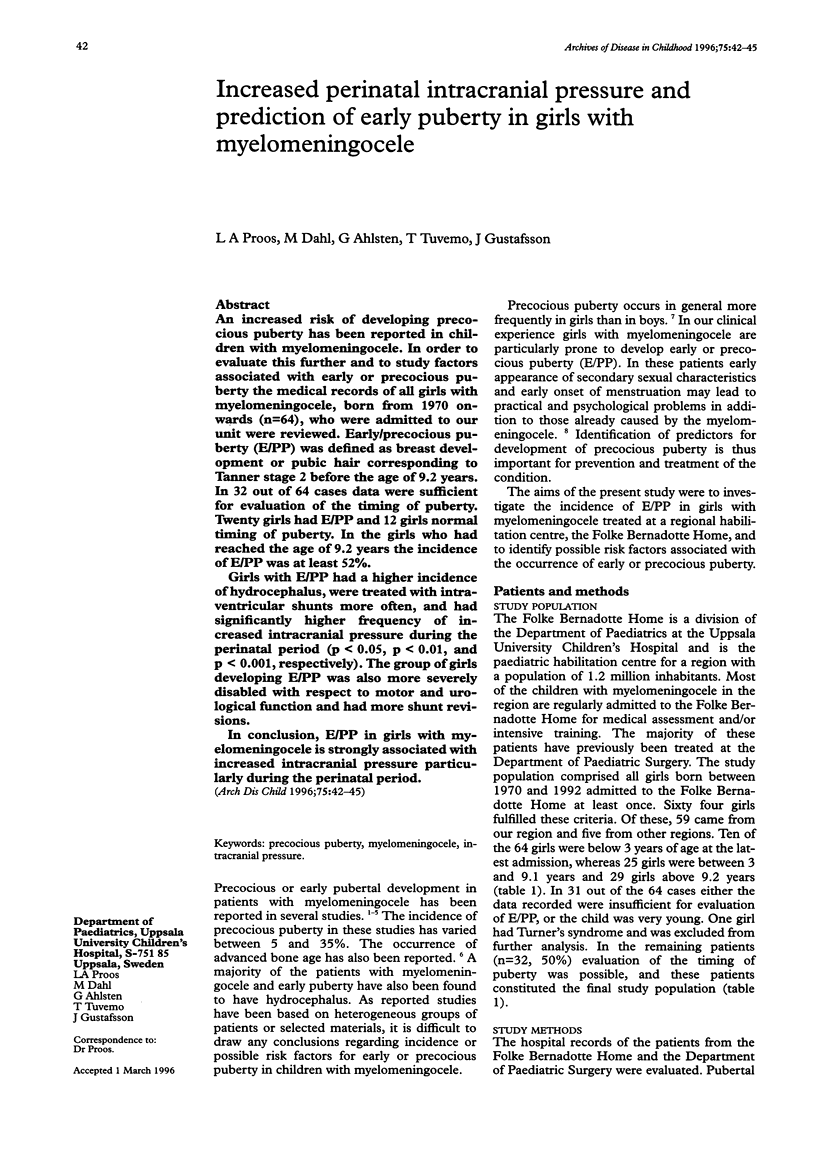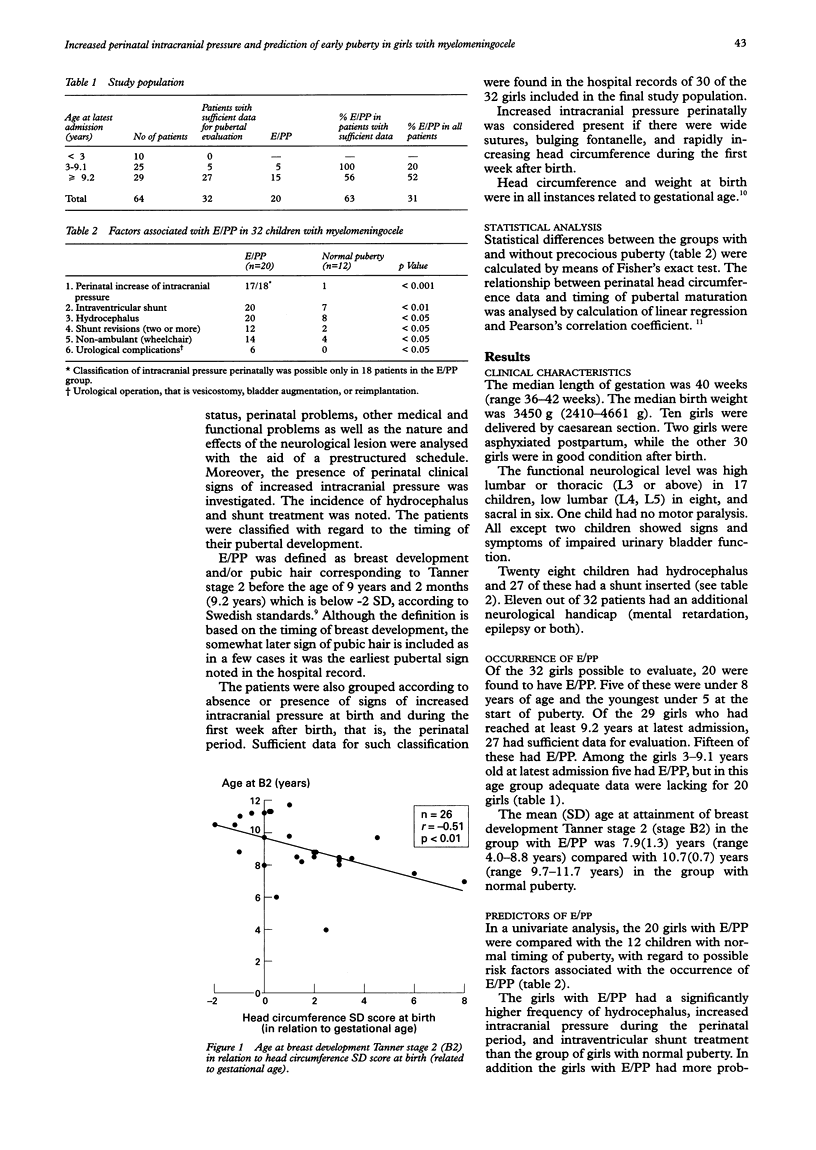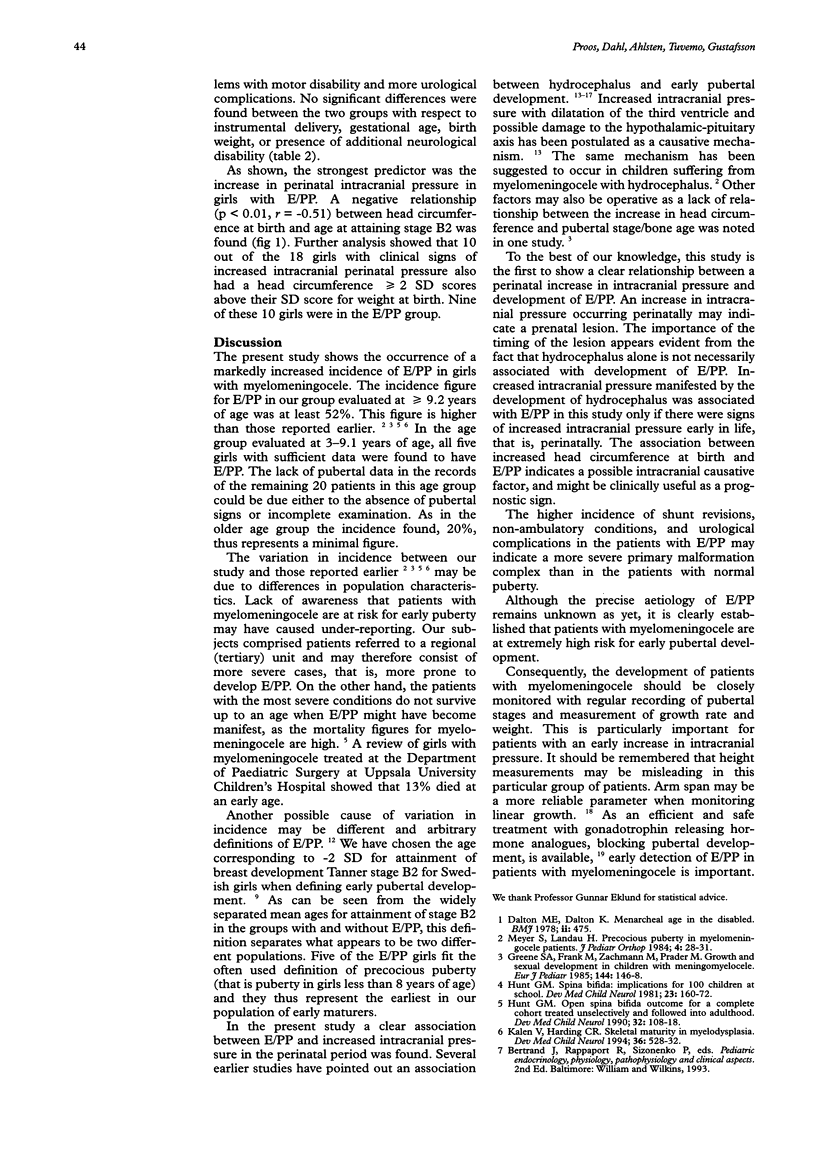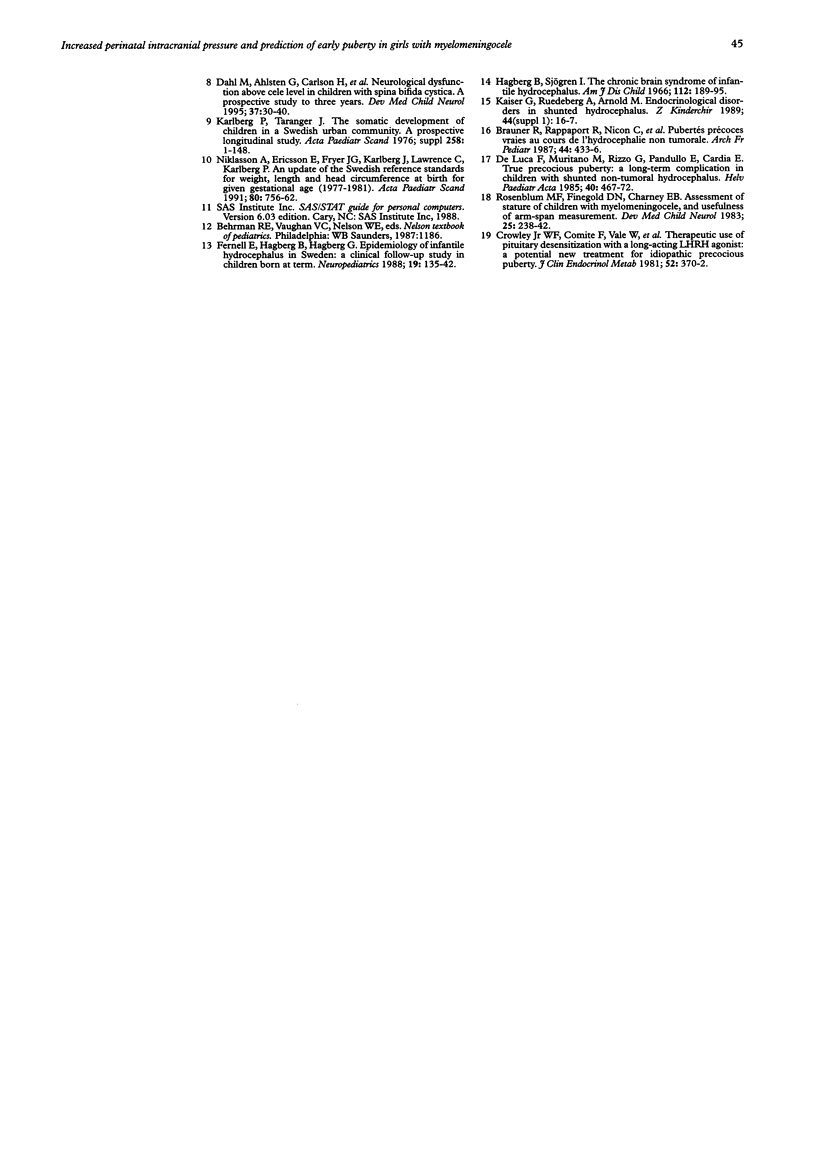Abstract
An increased risk of developing precocious puberty has been reported in children with myelomeningocele. In order to evaluate this further and to study factors associated with early or precocious puberty the medical records of all girls with myelomeningocele, born from 1970 onwards (n = 64), who were admitted to our unit were reviewed. Early/precocious puberty (E/PP) was defined as breast development or pubic hair corresponding to Tanner stage 2 before the age of 9.2 years. In 32 out of 62 cases data were sufficient for evaluation of the timing of puberty. Twenty girls had E/PP and 12 girls normal timing of puberty. In the girls who had reached the age of 9.2 years the incidence of E/PP was at least 52%. Girls with E/PP had a higher incidence of hydrocephalus, were treated with intraventricular shunts more often, and had significantly higher frequency of increased intracranial pressure during the perinatal period (p < 0.05, p < 0.01, and p < 0.001, respectively). The group of girls developing E/PP was also more severely disabled with respect to motor and urological function and had more shunt revisions. In conclusion, E/PP in girls with myelomeningocele is strongly associated with increased intracranial pressure particularly during the perinatal period.
Full text
PDF



Selected References
These references are in PubMed. This may not be the complete list of references from this article.
- Brauner R., Rappaport R., Nicod C., Malandry F., Thibaud E., Pierre-Kahn A., Renier D., Sainte-Rose C., Hirsch J. F. Pubertés précoces vraies au cours de l'hydrocéphalie non tumorale. Analyse de 16 observations. Arch Fr Pediatr. 1987 Jun-Jul;44(6):433–436. [PubMed] [Google Scholar]
- Dahl M., Ahlsten G., Carlson H., Ronne-Engström E., Lagerkvist B., Magnusson G., Norrlin S., Olsen L., Strömberg B., Thuomas K. A. Neurological dysfunction above cele level in children with spina bifida cystica: a prospective study to three years. Dev Med Child Neurol. 1995 Jan;37(1):30–40. doi: 10.1111/j.1469-8749.1995.tb11930.x. [DOI] [PubMed] [Google Scholar]
- Dalton M. E., Dalton K. Menarcheal age in the disabled. Br Med J. 1978 Aug 12;2(6135):475–475. doi: 10.1136/bmj.2.6135.475. [DOI] [PMC free article] [PubMed] [Google Scholar]
- De Luca F., Muritano M., Rizzo G., Pandullo E., Cardia E. True precocious puberty: a long-term complication in children with shunted non-tumoral hydrocephalus. Helv Paediatr Acta. 1985;40(6):467–472. [PubMed] [Google Scholar]
- Fernell E., Hagberg B., Hagberg G., Hult G., von Wendt L. Epidemiology of infantile hydrocephalus in Sweden: a clinical follow-up study in children born at term. Neuropediatrics. 1988 Aug;19(3):135–142. doi: 10.1055/s-2008-1052417. [DOI] [PubMed] [Google Scholar]
- Greene S. A., Frank M., Zachmann M., Prader A. Growth and sexual development in children with meningomyelocele. Eur J Pediatr. 1985 Jul;144(2):146–148. doi: 10.1007/BF00451900. [DOI] [PubMed] [Google Scholar]
- Hagberg B., Sjorgen I. The chronic brain syndrome of infantile hydrocephalus. A follow-up study of 63 spontaneously arrested cases. Am J Dis Child. 1966 Sep;112(3):189–196. doi: 10.1001/archpedi.1966.02090120057004. [DOI] [PubMed] [Google Scholar]
- Hunt G. M. Open spina bifida: outcome for a complete cohort treated unselectively and followed into adulthood. Dev Med Child Neurol. 1990 Feb;32(2):108–118. doi: 10.1111/j.1469-8749.1990.tb16910.x. [DOI] [PubMed] [Google Scholar]
- Hunt G. M. Spina bifida: implications for 100 children at school. Dev Med Child Neurol. 1981 Apr;23(2):160–172. doi: 10.1111/j.1469-8749.1981.tb02438.x. [DOI] [PubMed] [Google Scholar]
- Kaiser G., Ruedeberg A., Arnold M. Endocrinological disorders in shunted hydrocephalus. Z Kinderchir. 1989 Dec;44 (Suppl 1):16–17. doi: 10.1055/s-2008-1043283. [DOI] [PubMed] [Google Scholar]
- Kalen V., Harding C. R. Skeletal maturity in myelodysplasia. Dev Med Child Neurol. 1994 Jun;36(6):528–532. doi: 10.1111/j.1469-8749.1994.tb11883.x. [DOI] [PubMed] [Google Scholar]
- Karlberg P., Taranger J. The somatic development of children in a swedish urban community. Acta Paediatr Scand Suppl. 1976;(258):1–148. [PubMed] [Google Scholar]
- Meyer S., Landau H. Precocious puberty in myelomeningocele patients. J Pediatr Orthop. 1984 Jan;4(1):28–31. doi: 10.1097/01241398-198401000-00007. [DOI] [PubMed] [Google Scholar]
- Niklasson A., Ericson A., Fryer J. G., Karlberg J., Lawrence C., Karlberg P. An update of the Swedish reference standards for weight, length and head circumference at birth for given gestational age (1977-1981). Acta Paediatr Scand. 1991 Aug-Sep;80(8-9):756–762. doi: 10.1111/j.1651-2227.1991.tb11945.x. [DOI] [PubMed] [Google Scholar]


